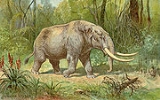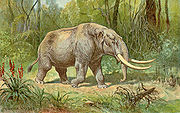
Hiscock Site
Encyclopedia

Byron, New York
Byron is a town in Genesee County, New York, United States. It was named in honor of Lord Byron. The town is on the northern border of the county, and lies northeast of the city of Batavia. The population was 2,493 at the 2000 census. The local school district, Byron-Bergen Central School District...
, Western
Western New York
Western New York is the westernmost region of the state of New York. It includes the cities of Buffalo, Rochester, Niagara Falls, the surrounding suburbs, as well as the outlying rural areas of the Great Lakes lowlands, the Genesee Valley, and the Southern Tier. Some historians, scholars and others...
New York
New York
New York is a state in the Northeastern region of the United States. It is the nation's third most populous state. New York is bordered by New Jersey and Pennsylvania to the south, and by Connecticut, Massachusetts and Vermont to the east...
, United States
United States
The United States of America is a federal constitutional republic comprising fifty states and a federal district...
that has yielded many mastodon
Mastodon
Mastodons were large tusked mammal species of the extinct genus Mammut which inhabited Asia, Africa, Europe, North America and Central America from the Oligocene through Pleistocene, 33.9 mya to 11,000 years ago. The American mastodon is the most recent and best known species of the group...
and paleo-Indian artifacts
Artifact (archaeology)
An artifact or artefact is "something made or given shape by man, such as a tool or a work of art, esp an object of archaeological interest"...
. Now owned by the Buffalo Museum of Science, it has been studied by archeological excavation and analysis since 1983.
Prehistoric 10,000 years ago
Around 10,000 years ago, the site was covered by Lake Tonawanda, which was formed by runoff from the melting and receding glaciers.Accidental discovery 1959
In 1959 the Hiscock family, for which the site is named, were using a backhoeBackhoe
A backhoe, also called a rear actor or back actor, is a piece of excavating equipment or digger consisting of a digging bucket on the end of a two-part articulated arm. They are typically mounted on the back of a tractor or front loader...
to deepen a pond. Their backhoe ripped a large tusk
Tusk
Tusks are elongated, continuously growing front teeth, usually but not always in pairs, that protrude well beyond the mouth of certain mammal species. They are most commonly canines, as with warthogs, wild boar, and walruses, or, in the case of elephants and narwhals, elongated incisors...
out of the ground. The Hiscocks contacted the Buffalo Museum of Science
Buffalo Museum of Science
Buffalo Museum of Science is a science museum located at Martin Luther King, Jr. Park in Buffalo, New York USA, northeast of the downtown district, near the Kensington Expressway. The historic building was designed by August Esenwein and James A. Johnson and opened in 1929...
about the site. For a time, it did not have the resources to mount an archeological excavation.
Excavations since 1983
The first excavations of the site began in 1983 and yielded surprising specimens. Dr. Richard LaubRichard Laub
Richard S. Laub is a scientist from the United States. He is curator of geology at the Buffalo Museum of Science, and directs excavations at the Hiscock Site in Byron, New York...
, curator at the Buffalo Museum, formally introduced the site to the world in 1986. In 1989, the Hiscock family donated 10 acres of the site to the Buffalo Museum of Science for research. The site has been excavated seasonally since 1983. More than 200 international volunteers have worked at the site, in addition to American researchers and students.
Prehistoric Mastodons

Extinction
In biology and ecology, extinction is the end of an organism or of a group of organisms , normally a species. The moment of extinction is generally considered to be the death of the last individual of the species, although the capacity to breed and recover may have been lost before this point...
genus
Genus
In biology, a genus is a low-level taxonomic rank used in the biological classification of living and fossil organisms, which is an example of definition by genus and differentia...
Mammut; they resemble modern elephants.
Native
Indigenous (ecology)
In biogeography, a species is defined as native to a given region or ecosystem if its presence in that region is the result of only natural processes, with no human intervention. Every natural organism has its own natural range of distribution in which it is regarded as native...
to North America
North America
North America is a continent wholly within the Northern Hemisphere and almost wholly within the Western Hemisphere. It is also considered a northern subcontinent of the Americas...
, mastodons lived on the continent
Continent
A continent is one of several very large landmasses on Earth. They are generally identified by convention rather than any strict criteria, with seven regions commonly regarded as continents—they are : Asia, Africa, North America, South America, Antarctica, Europe, and Australia.Plate tectonics is...
from almost 4 million years ago, in the Tertiary
Tertiary
The Tertiary is a deprecated term for a geologic period 65 million to 2.6 million years ago. The Tertiary covered the time span between the superseded Secondary period and the Quaternary...
period, until their eventual disappearance about 10,000 years ago. Mastodons also lived in Europe, from about five million years ago, but died out much earlier, 2 to 3 million years ago.
Mastodon fragments
MastodonMastodon
Mastodons were large tusked mammal species of the extinct genus Mammut which inhabited Asia, Africa, Europe, North America and Central America from the Oligocene through Pleistocene, 33.9 mya to 11,000 years ago. The American mastodon is the most recent and best known species of the group...
fragments such as large tusks, tusk tips, ivory
Ivory
Ivory is a term for dentine, which constitutes the bulk of the teeth and tusks of animals, when used as a material for art or manufacturing. Ivory has been important since ancient times for making a range of items, from ivory carvings to false teeth, fans, dominoes, joint tubes, piano keys and...
, ankle bone, teeth, skull
Skull
The skull is a bony structure in the head of many animals that supports the structures of the face and forms a cavity for the brain.The skull is composed of two parts: the cranium and the mandible. A skull without a mandible is only a cranium. Animals that have skulls are called craniates...
, and nural spine
Vertebral column
In human anatomy, the vertebral column is a column usually consisting of 24 articulating vertebrae, and 9 fused vertebrae in the sacrum and the coccyx. It is situated in the dorsal aspect of the torso, separated by intervertebral discs...
have been discovered in the excavations. More than 13 tusks have been found at the site. Analysis of the mastodon tusk tips has shown that the mastodons used their tusks to dig up sodium
Sodium
Sodium is a chemical element with the symbol Na and atomic number 11. It is a soft, silvery-white, highly reactive metal and is a member of the alkali metals; its only stable isotope is 23Na. It is an abundant element that exists in numerous minerals, most commonly as sodium chloride...
-rich clay
Clay
Clay is a general term including many combinations of one or more clay minerals with traces of metal oxides and organic matter. Geologic clay deposits are mostly composed of phyllosilicate minerals containing variable amounts of water trapped in the mineral structure.- Formation :Clay minerals...
during the last great paleo-drought.
Paleo-Indian artifacts
Evidence of paleo-Indians has also been discovered at the site, with flintFlint
Flint is a hard, sedimentary cryptocrystalline form of the mineral quartz, categorized as a variety of chert. It occurs chiefly as nodules and masses in sedimentary rocks, such as chalks and limestones. Inside the nodule, flint is usually dark grey, black, green, white, or brown in colour, and...
knappings, stone tools and projectile point
Projectile point
In archaeological terms, a projectile point is an object that was hafted to a projectile, such as a spear, dart, or arrow, or perhaps used as a knife....
. These were bound to sticks and lances for hunting.
Further reading
- RICHARD LAUB, NORTON G. MILLER and DAVID W. STEADMAN (eds.), Late Pleistocene and Early Holocene Paleoecology and Archeology of the Eastern Great Lakes Region: Proceedings of the Smith Symposium, held at the Buffalo Museum of Science, October 24-25, 1986: Buffalo Society of Natural Sciences Bulletin, vol. 33, 1988
- RICHARD LAUB, ed. The Hiscock Site: Late Pleistocene and Holocene Paleoecology and Archaeology of Western New York State, Proceedings of the Second Smith Symposium, held at the Buffalo Museum of Science, October 14-15, 2001: Buffalo Society of Natural Sciences Bulletin, vol. 37, 2003
- Richard Laub, "The Paleoindian presence in the Northeast: a view from the Hiscock Site," pp. 105-121, In Kurt W. Carr & James M. Adovasio (eds.), Ice Age Peoples of Pennsylvania, Pennsylvania Historical and Museum Commission (in coop. with the Pennsylvania Archaeological Council), 2002

